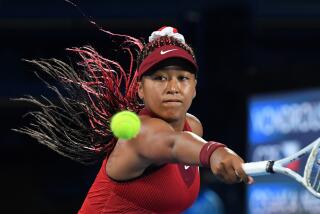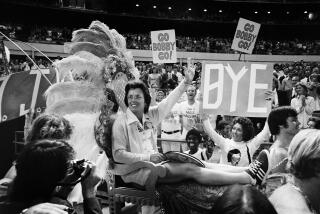Tennis : Graf’s Consistency Helped Her End Debate Over Who’s No. 1 in World
- Share via
Finally, just days after settling the long-running 1987 debate of who’s No. 1 in women’s tennis, Steffi Graf was ready to settle down.
The 18-year-old West German won 11 tournaments this year, including the French Open, and had claimed the No. 1 spot after winning the Virginia Slims of Los Angeles at Manhattan Beach in August. Graf, who won 75 matches and lost 2, had reached the final of all 13 tournaments in which she played in 1987, a first.
Until Graf won the Slims championships--held just before Thanksgiving--there was strong sentiment that if Navratilova won the year-end title, then she, not Graf, would be No. 1, despite what the computer said.
But Graf faced Gabriela Sabatini in the final, not Navratilova. Sabatini had defeated Navratilova in the quarterfinals, ending the talk of Navratilova’s claim to throne for this year, at least.
“Everything went amazingly consistent,” Graf said during a recent interview at her American home, the Gleneagles Country Club in Delray Beach, Fla.
“It wasn’t like--boom!--I was No. 1. I climbed slowly . . . fast. I never had any setbacks. I never went down.”
The two times Graf looked anything but spectacular were at Wimbledon, on her least favorite surface, grass, and the U.S. Open, where she was fighting a cold and a determined Navratilova.
After her straight-set loss to Navratilova at the Open, Graf heard the talk about No. 1 still being in doubt, even though the Women’s International Tennis Assn.’s computer would recognize her as the top player whether she lost to Navratilova or anyone else in New York.
Despite winning just four tournaments in 1987, Navratilova had won two Grand Slam titles--Wimbledon and the U.S. Open--to Graf’s one.
Thus, Navratilova was able to present a convincing quality-vs.-quantity argument. Graf heard that argument, too.
“I know,” she said. “I don’t even think about trading her year for mine. I think if you asked 1,000 people, 1,000 would say the same.”
Before returning to West Germany, Graf planned to spend some time with her father, Peter, and the rest of her family at the new home, learning to play golf and how to survive at South Florida shopping malls.
Graf, who was relaxed and friendly, discussed a number of topics:
--On the recent $1-million Stakes Match, won by Ivan Lendl--”I watched a lot of it and it was a great thing. It just wasn’t fair. I like Ivan, but (Pat) Cash should have got some . . . cash. I felt very sorry for him. After the first day, Stefan Edberg said he would be sponsoring the event if he kept losing. Well, Cash is already sponsoring it.”
--On reports that she will retire when she’s 28--”First of all, you can’t say that for sure. But that’s the latest I’ll play. I don’t want to be too old for my children.”
--On the expected showdown in New York between her and Navratilova that didn’t come off--”Everybody was talking about it. I think (Navratilova) was looking too much ahead and talking about it.”
The next opportunity for Graf and Navratilova to meet won’t be any earlier--not even in exhibitions--than at the Australian Open, Jan. 11-24. Graf did not play there last year--Navratilova lost to Hana Mandlikova in the final--and the traditional grass is gone this year, replaced by a new artificial surface.
Already, Navratilova, with yet another new coach, is looking forward to playing Down Under. She reached an agreement with Tim Gullikson and he worked with her at Chicago, producing a singles title in their first tournament together.
“He’s very technically oriented,” said Navratilova, who was at the Forum last week for an exhibition against Lori McNeil. “He’s very intellectual. I’m excited, too, because we really get along well off the court. When I’m down in Florida later this week, he wants me to come down to his home and work on some things there.”
Navratilova said that one of her previous coaches, Randy Crawford, was almost too laid-back in his approach.
“I had to tell him to make me work harder,” she said. “If I wanted to cut a workout short, he’d say, ‘OK.’ Whereas Tim would probably say, ‘Get your butt back out there.’ ”
Gullikson joked that he has already made the transformation from a player to a coach with little difficulty.
“I didn’t play too well,” he said after losing early in singles and doubles at the year-end final for the 35-and-over circuit last month. “The boys were teasing me that I made a very quick transition from a player to a coach.”
Gullikson wasn’t able to work with Navratilova at the year-end Slims championship in New York, but he was able to take note of her game in Chicago.
“There were a lot of things about her that impressed me,” he said. “First, she’s very talented, even more talented than I thought she’d be. She does everything well, she just needs a little fine-tuning.
“The second thing is her quickness. She’s unbelievably quick. But the biggest thing is her attitude and desire to improve and get back. After what she has accomplished it would be easy to sit back and feel tremendously satisfied.”
One of the biggest things missing at the first Stakes Match in West Palm Beach, Fla., was a true showman, a court-jester type.
Which brings us to Jimmy Connors.
Chuck Fairbanks, the creator of the Stakes Match format, said the organizers had spoken with Connors and Boris Becker about participating in the three-day event. Unfortunately, it didn’t fit into Connors’ schedule, for most likely he would have injected some levity into the almost workmanlike proceedings.
Unlike the golfers in the Skins Game, the four Stakes Match players were basically grim and dour.
“I didn’t get to see much of it,” Connors said. “I’m sure it created interest in tennis in a lot of ways. But I’m also sure it confused the public with the scoring system and Cash getting to the finals and coming away with nothing and someone else finishing third or fourth and getting a lot of money.
“Tennis needs something. They have to grope for something to get back on the path of the ‘70s and early ‘80s.”
More to Read
Go beyond the scoreboard
Get the latest on L.A.'s teams in the daily Sports Report newsletter.
You may occasionally receive promotional content from the Los Angeles Times.











